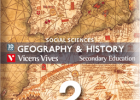Absolute Monarchy: The Catholic Monarchs
The 15th century marked the end of the Middle Ages and the beginning of the Modern Age. The Modern Age saw economic and population growth. There was also an increase in artisan activity and the circulation of money. The rule of the Catholic Monarchs replaced the feudal system, and they established an absolute monarchy. The Catholic Monarchs also unified most of the territories on the Peninsula.
Esta secuencia contiene:
-
10 actividades
-
64 recursos
-
Idioma:
- Inglés
-
Formato:
Interactivo
Secuencia didáctica
-
Didactic objectives Analyse the demographic, economic, and social transformations that took place in 15th century Europe. Know how political unification occurred on the Iberian Peninsula under the Catholic Monarchs. [...]
-
1. The Catholic Monarchs - dynastic union and territorial expansion Ferdinand, the future king of Aragon, and Isabella, the future queen of Castile, were married in 1469. They later became known as the Catholic Monarchs. [...]
-
The 15th century marked the end of the Middle Ages and the beginning of the Modern Age. The Modern Age saw economic and population growth. There was also an increase in artisan activity and the circulation of money. [...]
-
1.1. The union of Castile and Aragon Ferdinand, the future king of Aragon, and Isabella, the future queen of Castile, were married in 1469. They later became known as the Catholic Monarchs. [...]
-
2.1. The consolidation of royal power The Catholic Monarchs established a new system of government called absolute monarchy. The centre of their power was in Castile. [...]
-
3.1. Sheep farming in Castile The main economic activities in Castile in the 15th century were agriculture and livestock farming. The work of artisans also contributed to the economy in some cities. [...]
-
The reign of the Catholic Monarchs coincided with the introduction of Humanism and Renaissance art into Spain. [...]
-
5.1. Renaissance sculpture Renaissance sculpture in Spain is especially well-known for its religious themes. Sculptors emphasised religious feeling over beauty to evoke a sense of spirituality. [...]
-
The 15th century marked the end of the Middle Ages and the beginning of the Modern Age. The Modern Age saw economic and population growth. There was also an increase in artisan activity and the circulation of money. [...]
-
The 15th century marked the end of the Middle Ages and the beginning of the Modern Age. The Modern Age saw economic and population growth. There was also an increase in artisan activity and the circulation of money. [...]
Cursos y asignaturas
-
Aún no hay comentarios, ¡comparte tu opinión! Inicia sesión o Únete a Tiching para poder comentar
La licencia digital es una autorización que permite utilizar un recurso digital de acuerdo con las condiciones legales de dicho recurso. El código que recibas una vez la hayas comprado te permitirá acceder al recurso educativo digital elegido.
Puedes consultar más información en nuestra página de ayuda.







































































¿Dónde quieres compartirlo?
¿Quieres copiar el enlace?